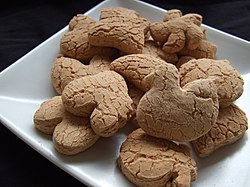Kue bangkit
 Kue bangkit, "rising" sago cookie | |
| Alternative names | Kuih bangkit |
|---|---|
| Type | Cookie |
| Course | Snack, dessert |
| Place of origin | Indonesia[1][2] Malaysia[3][4][5] |
| Region or state | Indonesia,[6][7] Malaysia, Brunei and Singapore |
| Main ingredients | Sago or tapioca starch, coconut milk, egg, sugar |
Kue bangkit is a small biscuit (kue or kuih) that made from sago starch of Malay origin,[2] commonly found in Indonesia[1] and Malaysia. This biscuit has various colours, ranging from white, yellowish to brown, depends on the additional ingredients.
In Indonesia, kue bangkit is associated with Malays community of Riau[8] and Riau Islands provinces.[9][1][2] While in Malaysia, kuih bangkit is associated with Malays and Nyonya communities.[10] It is one of the typical traditional Malay cookie, mostly associated with Hari Raya and Chinese New Year.[3]
Etymology[]
This coconut sago cookie is called as kue bangkit in Indonesia, and kuih bangkit in Malaysia. The term bangkit in Malay language means "rise" refer to the fact that the biscuit expands twice the size after baking.[1][10]
Ingredients[]
Kue bangkit ingredients consists of sago or tapioca starch, thick coconut milk, sugar, egg yolks, pandan leaf, margarine and salt. Sometimes vanilla extract and gula aren (palm sugar) might be used for a better aroma.[8]
The texture of the kue bangkit is very crispy and tends to be brittle. The dough is molded using small cookie molds, and subsequently the cookies being baked using oven. Eating this cake will give the sensation of melting in the mouth. However, the texture remains crispy when chewed. Kue bangkit has a sweet and savory flavour.
See also[]
- Kue satu
- Kue lidah kucing
- Kue
- List of cookies
- List of Indonesian dishes
- List of Indonesian snacks
- Malaysian Cuisine
References[]
- ^ Jump up to: a b c d Arman, Dedi (3 January 2019). "Kue Bangkit, Cemilan dari Kundur". Kementerian Pendidikan dan Kebudayaan Republik Indonesia, Balai Pelestarian Nilai Budaya Kepulauan Riau (in Indonesian). Retrieved 2020-11-09.
- ^ Jump up to: a b c "Rahma: "Kue Melayu Harus Diekspos"". Lintas Kepri (in Indonesian). 9 September 2020. Retrieved 2020-11-09.
- ^ Jump up to: a b "Origins: The Meaning Behind Chinese New Year Goodies From Around the World". MICHELIN Guide. Retrieved 2020-11-09.
- ^ Wu, David Y. H.; Tan, Chee Beng (2001). Changing Chinese Foodways in Asia. ISBN 9789622019140.
- ^ Ng, Chien Y.; Ab. Karim, Shahrim (June 2016). "Historical and contemporary perspectives of the Nyonya food culture in Malaysia". Journal of Ethnic Foods. 3 (2): 93–106. doi:10.1016/j.jef.2016.05.004.
- ^ "Kue Bangkit khas Riau Enak dan Anti Gagal - Resep". ResepKoki (in Indonesian). Retrieved 2020-06-08.
- ^ "Mengenal Resep Kue Bangkit yang Praktis dan Sedap". blueband.co.id (in Indonesian). Retrieved 2020-06-08.
- ^ Jump up to: a b Setyorini, Tantri. "Resep Kue Bangkit Sagu Gula Aren". merdeka.com (in Indonesian). Retrieved 2020-11-09.
- ^ adminraya (18 October 2018). "Kue Bangkit, Jajanan Khas Kepulauan Riau". BatamRaya.com (in Indonesian). Retrieved 2020-11-09.
- ^ Jump up to: a b Team, Butterkicap (2019-02-01). "Tapioca cookies: Traditional Kuih Bangkit for modern bakers". Free Malaysia Today. Retrieved 2020-11-09.
External links[]
| Wikimedia Commons has media related to Kue bangkit. |
- Cookies
- Indonesian snack foods
- Kue
- Malaysian cuisine

